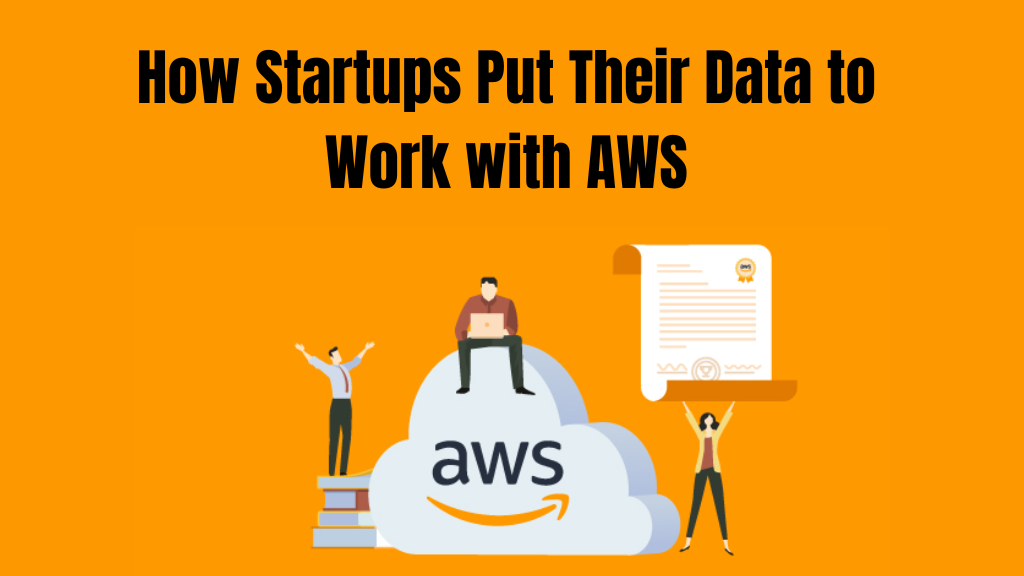Lets know about How Startups Put Their Data to Work with AWS? leveraging data effectively can mean the difference between success and failure. As these companies aim to scale rapidly and compete in competitive markets, the ability to harness data for decision-making, innovation, and customer satisfaction is crucial. Amazon Web Services (AWS) has emerged as a vital partner for startups looking to optimize their data strategies. This comprehensive guide explores how startups are putting their data to work using AWS, focusing on various services, best practices, and real-world examples.
1. Introduction How Startups Put Their Data to Work with AWS?
Amazon Web Services (AWS) provides a suite of cloud computing services that enable startups to scale their operations, reduce costs, and innovate quickly. For data-driven startups, AWS offers robust tools and services designed to manage, process, analyze, and visualize data efficiently. Here’s how startups can leverage AWS to make the most of their data.
1.1 Why AWS?
And information need to know about How Startups Put Their Data to Work with AWS?
- Scalability: AWS services are highly scalable, allowing startups to start small and expand their resources as their needs grow.
- Cost-Effectiveness: With a pay-as-you-go pricing model, AWS helps startups manage their budgets effectively.
- Security: AWS provides top-tier security measures to protect data integrity and privacy.
- Innovation: AWS continuously evolves, offering new services and features that keep startups at the forefront of technological advancements.
- Support: AWS provides extensive documentation, support plans, and a vibrant community to assist startups in their journey.
2. AWS Data Services for Startups
AWS offers a plethora of services tailored to different aspects of data management and analytics. Let’s delve into some of the key services that startups use to put their data to work.How Startups Put Their Data to Work with AWS?
2.1 Amazon S3 (Simple Storage Service)
Amazon S3 is a scalable object storage service that startups use to store and retrieve any amount of data at any time. It is designed to deliver 99.999999999% durability and is ideal for storing data that is used for data lakes, websites, mobile applications, backup and restore, and more.
- Use Case: Startups can use Amazon S3 to store raw data collected from various sources. This data can then be processed and analyzed using other AWS services.
2.2 Amazon RDS (Relational Database Service)
Amazon RDS simplifies the setup, operation, and scaling of a relational database in the cloud. It provides cost-efficient, How Startups Put Their Data to Work with AWS? resizable capacity while automating time-consuming administration tasks such as hardware provisioning, database setup, patching, and backups.
- Use Case: Startups that rely on structured data for their applications can use Amazon RDS to manage their databases efficiently without worrying about the underlying infrastructure.
2.3 Amazon Redshift
Amazon Redshift is a fully managed data warehouse that allows startups to run complex queries and analytics on large datasets quickly. It integrates seamlessly with data visualization tools, enabling startups to derive actionable insights.
- Use Case: For startups needing to analyze vast amounts of data to drive business decisions, Amazon Redshift offers a powerful solution for data warehousing and analytics.
2.4 AWS Lambda
AWS Lambda lets startups run code without provisioning or managing servers. It automatically scales and only charges for the compute time consumed. Lambda is ideal for processing data streams, running backend services, and handling real-time data processing.
- Use Case: Startups can use AWS Lambda to process data in real-time, such as streaming data from IoT devices or processing logs from web applications.
2.5 Amazon DynamoDB
Amazon DynamoDB is a fully managed NoSQL database service that provides fast and predictable performance with seamless scalability. It’s designed for applications that require consistent, single-digit millisecond latency at any scale.
- Use Case: Startups building applications that need to handle large volumes of unstructured data, such as mobile apps or gaming platforms, can benefit from DynamoDB’s performance and scalability.
2.6 Amazon Kinesis
Amazon Kinesis makes it easy to collect, process, and analyze real-time, streaming data. With Kinesis, startups can ingest real-time data such as video, audio, application logs, website clickstreams, How Startups Put Their Data to Work with AWS? and IoT telemetry data.
- Use Case: Startups that need to process and analyze streaming data in real-time, such as monitoring applications or IoT devices, can leverage Amazon Kinesis for efficient data handling.
3. Data Processing and Analytics
Processing and analyzing data are critical steps in turning raw data into valuable insights. AWS provides a range of tools to help startups with these tasks.
3.1 Amazon EMR (Elastic MapReduce)
Amazon EMR is a cloud big data platform that processes vast amounts of data quickly and cost-effectively at scale using popular open-source tools such as Apache Hadoop, Spark, and HBase.How Startups Put Their Data to Work with AWS?
- Use Case: Startups needing to perform large-scale data processing tasks, such as machine learning, data transformations, and ETL (extract, transform, load) jobs, can use Amazon EMR for its scalability and cost-effectiveness.
3.2 AWS Glue
AWS Glue is a fully managed ETL service that makes it easy to prepare and load data for analytics. It automates the tedious and time-consuming tasks of data preparation.
- Use Case: Startups can use AWS Glue to clean, enrich, and prepare data for analysis in a data warehouse or data lake.
3.3 Amazon Athena
Amazon Athena is an interactive query service that makes it easy to analyze data in Amazon S3 using standard SQL. Athena is serverless, so there is no infrastructure to manage, and you pay only for the queries you run.
- Use Case: Startups looking for a cost-effective and straightforward way to query their data stored in S3 can use Amazon Athena without the need for complex data warehousing solutions.
3.4 Amazon QuickSight
Amazon QuickSight is a scalable, serverless business intelligence (BI) service that allows startups to create and publish interactive dashboards. It integrates seamlessly with various AWS services and databases.
- Use Case: Startups can use Amazon QuickSight to create visualizations and share insights across the organization, driving data-driven decision-making.
4. Machine Learning and Artificial Intelligence
AWS offers a wide range of services for machine learning (ML) and artificial intelligence (AI), enabling startups to build, train, and deploy models quickly.How Startups Put Their Data to Work with AWS?
4.1 Amazon SageMaker
Amazon SageMaker is a fully managed service that provides every developer and data scientist with the ability to build, train, and deploy ML models quickly. How Startups Put Their Data to Work with AWS? It covers the entire machine learning workflow to label and prepare data, choose an algorithm, train the model, tune and optimize it for deployment, make predictions, and take action.
- Use Case: Startups can leverage Amazon SageMaker to build and deploy ML models for a variety of applications, such as predictive analytics, customer segmentation, and recommendation engines.
4.2 AWS Rekognition
AWS Rekognition is a service that makes it easy to add image and video analysis to your applications. It can identify objects, people, text, scenes, and activities in images and videos, as well as detect any inappropriate content.
- Use Case: Startups in the media and entertainment, security, and retail industries can use AWS Rekognition for image and video analysis, enhancing their applications with AI capabilities.
4.3 Amazon Comprehend
Amazon Comprehend is a natural language processing (NLP) service that uses machine learning to find insights and relationships in text. It can analyze text to extract key phrases, sentiment, entities, and language.
- Use Case: Startups can use Amazon Comprehend to analyze customer feedback, social media posts, and other text data to gain valuable insights into customer sentiment and behavior.
4.4 Amazon Lex
Amazon Lex is a service for building conversational interfaces into any application using voice and text.How Startups Put Their Data to Work with AWS? Lex provides the deep functionality and flexibility of natural language understanding (NLU) and automatic speech recognition (ASR).
- Use Case: Startups can use Amazon Lex to build chatbots and voice assistants for customer support, enhancing user experience and reducing operational costs.
5. Real-World Examples
To illustrate how startups are successfully leveraging AWS to put their data to work, let’s look at some real-world examples.
5.1 Airbnb
Airbnb, a global leader in the travel industry, uses AWS to handle its massive data needs. By leveraging Amazon S3 for data storage and Amazon Redshift for data warehousing,How Startups Put Their Data to Work with AWS? Airbnb can process and analyze vast amounts of data to provide personalized recommendations and improve customer experiences.
5.2 Slack
Slack, a popular collaboration platform, uses AWS to manage and process its data. With Amazon S3 and Amazon RDS, Slack ensures that its data is securely stored and easily accessible. AWS Lambda is used to automate backend processes, allowing Slack to scale efficiently.
5.3 Lyft
Lyft, a leading ride-sharing company, uses AWS to handle its real-time data processing needs. By using Amazon Kinesis, Lyft can process and analyze streaming data from its fleet of vehicles to optimize routes, reduce wait times, and enhance the overall user experience.
5.4 Pinterest
Pinterest relies on AWS to manage its vast amounts of image data. Using Amazon S3 for storage and Amazon EMR for data processing, Pinterest can efficiently handle billions of images and provide users with fast and relevant search results.
6. Best Practices for Startups Using AWS
To maximize the benefits of AWS, startups should follow best practices in data management, security, and cost optimization.How Startups Put Their Data to Work with AWS?
6.1 Data Management
- Data Governance: Establish clear data governance policies to ensure data quality, security, and compliance.
- Data Lifecycle Management: Implement data lifecycle management to archive or delete old data, reducing storage costs.
- Data Backup: Regularly back up critical data to prevent data loss and ensure business continuity.
6.2 Security
- Encryption: Use AWS encryption services to protect data at rest and in transit.
- Access Control: Implement strict access controls using AWS Identity and Access Management (IAM) to limit access to sensitive data.
- Monitoring: Use AWS CloudTrail and Amazon CloudWatch to monitor and log all activities, enhancing security and compliance.
6.3 Cost Optimization
- Resource Management: Use AWS Cost Explorer and AWS Trusted Advisor to monitor and optimize resource usage.
- Reserved Instances: Consider using Reserved Instances for predictable workloads to save on long-term costs.
- Auto Scaling: Implement auto-scaling to ensure you only pay for the resources you need during peak and off-peak times.
How Startups Put Their Data to Work with AWS? Startups have a unique opportunity to leverage AWS to turn their data into a strategic asset. By utilizing AWS’s comprehensive suite of services for data storage, processing, analytics, and machine learning, startups can gain valuable insights, enhance customer experiences, and drive innovation. As we’ve seen from real-world examples like Airbnb, Slack, Lyft, and Pinterest, the potential for growth and success with AWS is immense.How Startups Put Their Data to Work with AWS? By following best practices in data management, security, and cost optimization, startups can maximize their AWS investments and achieve their business objectives.


1 thought on “How Startups Put Their Data to Work with AWS?”